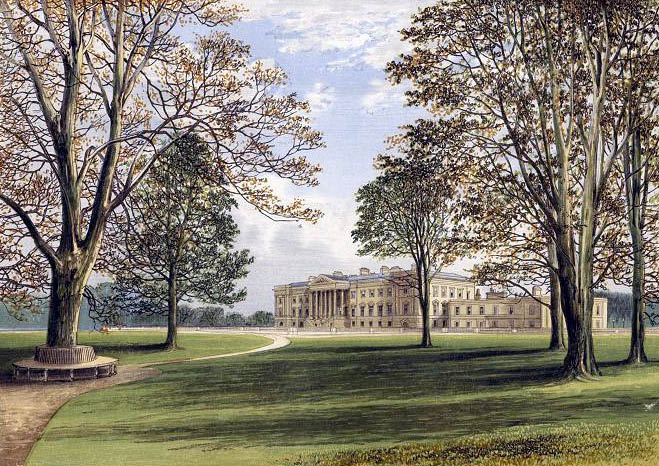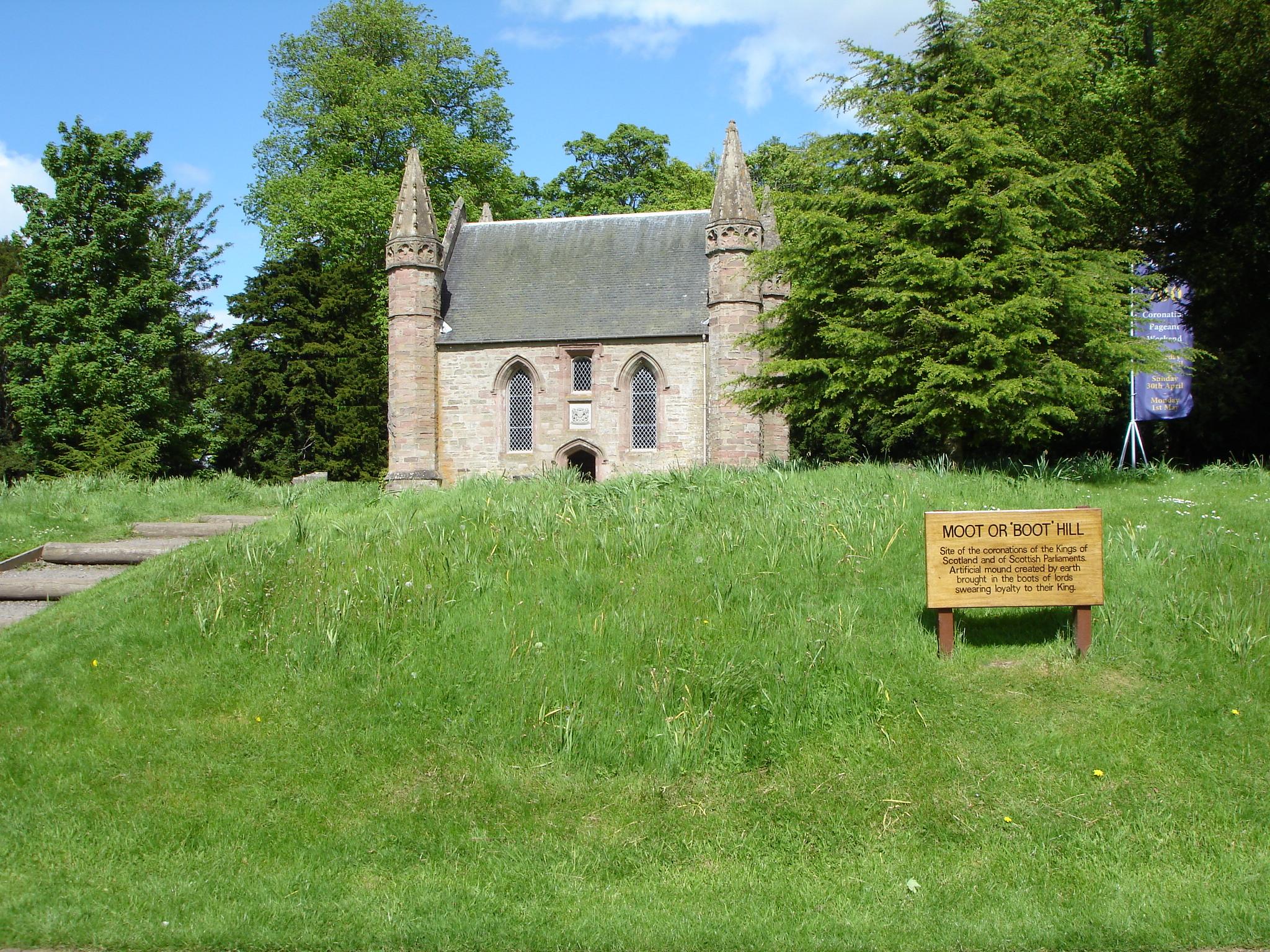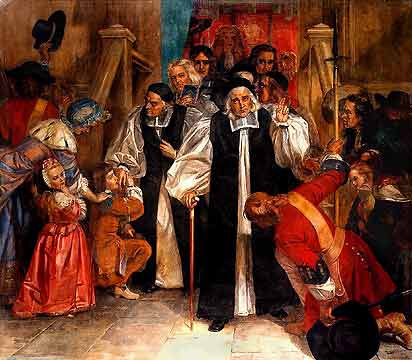|
Convention Of Estates (1689)
The 1689 Convention of Estates sat between 16 March 1689 and 5 June 1689 to determine the settlement of the Scottish throne, following the deposition of James VII in the 1688 Glorious Revolution. The Convention of the Estates of Scotland was a sister-institution to Parliament, comprising the three estates of bishops, barons and representatives of the Burghs. Historically, it had been summoned by the king of Scots for the limited purpose of raising taxes, and could not pass other legislation. Unlike the English Convention Parliament of 1689, the 1689 Scottish Convention was also a contest for control of the Church of Scotland or Kirk. While Scotland played no part in the landing in England and there was little enthusiasm for William and Mary, by November 1688 only a tiny minority actively supported James. Many of William's exile advisors were Scots, including Melville, Argyll, his personal chaplain, William Carstares, and Gilbert Burnet, his chief propagandist. News of Jam ... [...More Info...] [...Related Items...] OR: [Wikipedia] [Google] [Baidu] |
Kingdom Of Scotland
The Kingdom of Scotland (; , ) was a sovereign state in northwest Europe traditionally said to have been founded in 843. Its territories expanded and shrank, but it came to occupy the northern third of the island of Great Britain, sharing a land border to the south with England. It suffered many invasions by the English, but under Robert the Bruce it fought a successful War of Independence and remained an independent state throughout the late Middle Ages. Following the annexation of the Hebrides and the Northern Isles from Norway in 1266 and 1472 respectively, and the final capture of the Royal Burgh of Berwick by England in 1482, the territory of the Kingdom of Scotland corresponded to that of modern-day Scotland, bounded by the North Sea to the east, the Atlantic Ocean to the north and west, and the North Channel and Irish Sea to the southwest. In 1603, James VI of Scotland became King of England, joining Scotland with England in a personal union. In 1707, d ... [...More Info...] [...Related Items...] OR: [Wikipedia] [Google] [Baidu] |
William Hamilton, Duke Of Hamilton
William Douglas-Hamilton, Duke of Hamilton, KG, PC (24 December 1634 – 18 April 1694), also known as Lord William Douglas and the Earl of Selkirk, was a Scottish nobleman and politician. He was the eldest son of The 1st Marquess of Douglas by his second wife, Lady Mary Gordon, a daughter of The 1st Marquess of Huntly. Subsequent to marrying Anne Hamilton, 3rd Duchess of Hamilton, he was created Duke of Hamilton in the Peerage of Scotland, which also allowed him to use his wife's subsidiary titles during his lifetime and to take the name Hamilton for their descendants. Early life and marriage Lord William Douglas was created Earl of Selkirk in 1646, at the age of 11. He supported the Royalist cause in the Wars of the Three Kingdoms and was fined £,1000, under the terms of the English Commonwealth's Act of Pardon and Grace to the People of Scotland. On 29 April 1656, he married Anne Hamilton, Duchess of Hamilton. She was from a staunchly Royalist dynasty. Her estates had ... [...More Info...] [...Related Items...] OR: [Wikipedia] [Google] [Baidu] |
Rival Successions
A rivalry is the state of two people or groups engaging in a lasting competitive relationship. Rivalry is the "against each other" spirit between two competing sides. The relationship itself may also be called "a rivalry", and each participant or side a rival to the other. Someone's main rival may be called an archrival. A rivalry can be defined as "a perceptual categorizing process in which actors identify which states are sufficiently threatening competitors". In order for the rivalry to persist, rather than resulting in perpetual dominance by one side, it must be "a competitive relationship among equals". Political scientist John A. Vasquez has asserted that equality of power is a necessary component for a true rivalry to exist, but others have disputed that element. Rivalries traverse many different fields within society and "abound at all levels of human interaction", often existing between friends, firms, sports teams, schools, and universities. Moreover, "families, politi ... [...More Info...] [...Related Items...] OR: [Wikipedia] [Google] [Baidu] |
Parliament Of Scotland
The Parliament of Scotland ( sco, Pairlament o Scotland; gd, Pàrlamaid na h-Alba) was the legislature of the Kingdom of Scotland from the 13th century until 1707. The parliament evolved during the early 13th century from the king's council of bishops and earls, with the first identifiable parliament being held in 1235 during the reign of Alexander II, when it already possessed a political and judicial role. A unicameral institution, for most of its existence the Parliament consisted of the three estates of clergy, nobility, and the burghs. By the 1690s it comprised the nobility, the shires, the burghs, and various officers of state. Parliament gave consent for the raising of taxation and played an important role in the administration of justice, foreign policy, war, and the passing of a broad range of legislation. Parliamentary business was also carried out by "sister" institutions, such as General Councils or Conventions of Estates, which could both carry out much busi ... [...More Info...] [...Related Items...] OR: [Wikipedia] [Google] [Baidu] |
Jacobitism
, war = , image = Prince James Francis Edward Stuart by Louis Gabriel Blanchet.jpg , image_size = 150px , caption = James Francis Edward Stuart, Jacobite claimant between 1701 and 1766 , active = 1688–1780s , ideology = * Legitimist support for the senior line of the Stuarts * Indefeasible dynastic right * Divine right of kings * Irish nationalism * Scottish nationalism , leaders = , leader1_title = Military leaders , leader1_name = , headquarters = , area = British Isles , size = , allies = *Papal States (Until 1788) , opponents = Jacobitism (; gd, Seumasachas, ; ga, Seacaibíteachas, ) was a political movement that supported the restoration of the senior line of the House of Stuart to the British throne. The name derives from the first name of James II and VII, which in Latin translates as ''Jacobus''. When James went into exile ... [...More Info...] [...Related Items...] OR: [Wikipedia] [Google] [Baidu] |
Nonjuring Schism
The Nonjuring schism refers to a split in the established churches of England, Scotland and Ireland, following the deposition and exile of James II and VII in the 1688 Glorious Revolution. As a condition of office, clergy were required to swear allegiance to the ruling monarch; for various reasons, some refused to take the oath to his successors William III and II and Mary II. These individuals were referred to as ''Non-juring'', from the Latin verb ''iūrō'', or ''jūrō'', meaning "to swear an oath". In the Church of England, an estimated 2% of priests refused to swear allegiance in 1689, including nine bishops. Ordinary clergy were allowed to keep their positions but after efforts to compromise failed, the six surviving bishops were removed in 1691. The schismatic Non-Juror Church was formed in 1693 when Bishop Lloyd appointed his own bishops. His action was opposed by the majority of English Non-Jurors, who remained within the Church of England and are sometimes referre ... [...More Info...] [...Related Items...] OR: [Wikipedia] [Google] [Baidu] |
Jacobite Rising Of 1689
The Jacobite rising of 1689 was a conflict fought primarily in the Scottish Highlands, whose objective was to put James II of England, James II & VII back on the throne, following his deposition by the November 1688 Glorious Revolution. Named after "Jacobus", the Latin for James, his supporters were known as 'Jacobites' and the associated political movement as Jacobitism. The 1689 rising was the first of a series of rebellions and plots seeking to restore the House of Stuart that continued into the late 18th century. Part of the wider European conflict known as the Nine Years War, the Scottish revolt was intended to support the 1689 to 1691 Williamite War in Ireland. Despite a decisive Jacobite victory at Battle of Killiecrankie, Killiecrankie in July 1689, their charismatic leader John Graham, 1st Viscount Dundee was killed in the final attack. His death, combined with limited internal or external support, meant the rising never presented a real threat to the new administration ... [...More Info...] [...Related Items...] OR: [Wikipedia] [Google] [Baidu] |
Claim Of Right Act 1689
The Claim of Right (c. 28) is an Act passed by the Convention of the Estates, a sister body to the Parliament of Scotland (or Three Estates), in April 1689. It is one of the key documents of United Kingdom constitutional law and Scottish constitutional law. Background In the Glorious Revolution, William of Orange landed with his army in England on 5 November 1688. King James VII of Scotland, who was also King of England and Ireland as James II, attempted to resist the invasion. He then sent representatives to negotiate, and he finally fled England on 23 December 1688. Whilst the Convention Parliament in England declared that James, as King of England, had abdicated the Government, and issued an English Bill of Rights on 13 February 1689 offering the Crown of England to William and Mary, the Scots found themselves facing a more difficult constitutional problem. As James had not been present in Scotland during the crisis and had not fled from Scottish territory in Decem ... [...More Info...] [...Related Items...] OR: [Wikipedia] [Google] [Baidu] |
Divine Right Of Kings
In European Christianity, the divine right of kings, divine right, or God's mandation is a political and religious doctrine of political legitimacy of a monarchy. It stems from a specific metaphysical framework in which a monarch is, before birth, pre-ordained to inherit the crown. According to this theory of political legitimacy, the subjects of the crown have actively (and not merely passively) turned over the metaphysical selection of the king's soul – which will inhabit the body and rule them – to God. In this way, the "divine right" originates as a metaphysical act of humility and/or submission towards God. Divine right has been a key element of the legitimisation of many absolute monarchies. Significantly, the doctrine asserts that a monarch is not accountable to any earthly authority (such as a parliament) because their right to rule is derived from divine authority. Thus, the monarch is not subject to the will of the people, of the aristocracy, or of any ot ... [...More Info...] [...Related Items...] OR: [Wikipedia] [Google] [Baidu] |
John Graham, 1st Viscount Dundee
John Graham, 7th of Claverhouse, 1st Viscount Dundee (21 July 1648 – 27 July 1689) was a Scottish soldier and nobleman, a Tory and an Episcopalian. He was responsible for policing southwest Scotland during and after the religious unrest and rebellion of the late 17th century, and went on to lead the Jacobite rising of 1689. After his death, Presbyterian historians dubbed him "Bluidy Clavers". Contemporary evidence for the fairness of this soubriquet in the Covenanting tradition is mixed. Tales of the Covenanters and Covenanter monuments hold Claverhouse directly responsible for the deaths of adherents of that movement. However, Claverhouse's own letters frequently recommended lenient treatment of Covenanters,Letters of John Grahame of Claverhouse, Viscount of Dundee – James Bannatyne, Edinburgh (1824) and in 1684 he married into a prominent Covenanter family. Later, as a general in the Scottish army, Claverhouse remained loyal to King James VII of Scotland after the Rev ... [...More Info...] [...Related Items...] OR: [Wikipedia] [Google] [Baidu] |
Edinburgh Castle
Edinburgh Castle is a historic castle in Edinburgh, Edinburgh, Scotland. It stands on Castle Rock (Edinburgh), Castle Rock, which has been occupied by humans since at least the Iron Age, although the nature of the early settlement is unclear. There has been a royal castle on the rock since at least the reign of David I of Scotland, David I in the 12th century, and the site continued to be a royal residence until 1633. From the 15th century, the castle's residential role declined, and by the 17th century it was principally used as military barracks with a large garrison. Its importance as a part of Scotland's national heritage was recognised increasingly from the early 19th century onwards, and various restoration programmes have been carried out over the past century and a half. As one of the most important strongholds in the Kingdom of Scotland, Edinburgh Castle was involved in many historical conflicts from the Wars of Scottish Independence in the 14th century to the Jacobite ... [...More Info...] [...Related Items...] OR: [Wikipedia] [Google] [Baidu] |
George Gordon, 1st Duke Of Gordon
George Gordon, 1st Duke of Gordon KT, PC (1643 – 7 December 1716), known as Marquess of Huntly from 1661 to 1684, was a Scottish peer. George Gordon, 4th Marquess of Huntly was born in 1643, the son of Lewis Gordon, 3rd Marquess of Huntly and Mary Grant. He was originally styled the Earl of Enzie until his succession as Marquess in December 1653, when he was around four years old. The young Marquess was educated at a Catholic seminary in France, following a tradition within the Huntly family. In 1673, when he was aged 24, he entered the French Army of Louis XIV and served under the famous Marshal de Turenne before returning to Scotland sometime around 1675. In October of the following year, 1676, he married Lady Elizabeth Howard, the second daughter of Henry Howard, 6th Duke of Norfolk. However, he was described by the historian Macky as someone "made for the company of ladies, but is covetous which extremely eclipses him." The marriage was not wholly successful an ... [...More Info...] [...Related Items...] OR: [Wikipedia] [Google] [Baidu] |






.jpg)



